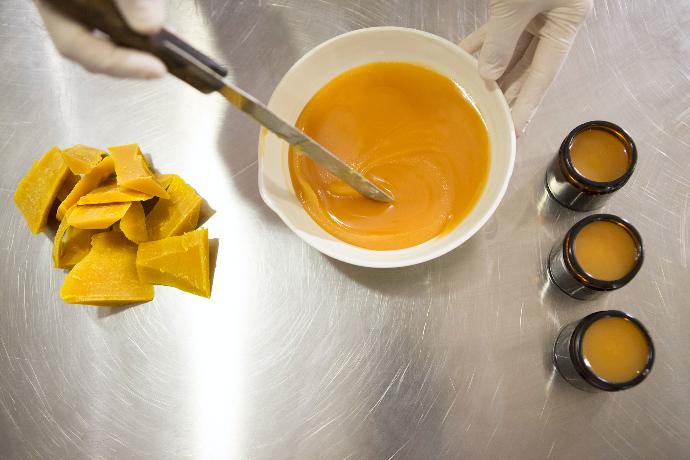The relationship between man and bee has been established since prehistoric times, as evidenced by cave paintings in the Valencia region (Spain). From empirical knowledge to medical thesis, through scientific studies, the use of honey in natural therapeutics is no longer debated. Some French hospitals have chosen to integrate it in their care protocol, such as the CHU of Limoges which has published a brochure as a guide for the use of honey to heal different wounds.
Honey, a product of the hive
Honey is the product of the hive obtained by the work of the bees. With their proboscis-like tongue, they collect nectar from flowers and store it in their crop to bring it back to the hive.
They then regurgitate their nectar collection into the crop of worker bees. The latter will regurgitate the nectar thus received into the crop of other workers. This is the phenomenon of trophallaxis which gradually leads to the dehydration of the nectar which thickens and turns into honey.
This honey is rich in levulose and glucose which are sugars.
What to treat with honey?
The wounds
Accidental superficial wounds or wounds caused by surgical incision and without infection can benefit from a honey dressing.
Soiled or infected wounds require a swab to analyze the bacteria involved and can then be treated with a honey dressing.
Large wounds will heal faster with honey.
Les escarres
Some conditions may make it impossible for the patient to move. For example, lying down and immobilization can lead to tissue compression and poor blood supply, resulting in pressure sores despite daily care.
The application of honey on the necrotic areas after cleaning the area accelerates healing while avoiding the use of antibiotics.

Burns
1st and 2nd degree burns can receive an immediate application of honey dressing. This reduces pain, prevents the formation of phlyctenes, and helps to prevent the formation of ulcers.It accelerates tissue renewal and healing.
Honey dressings on burns have been shown to reduce the risk of severe scarring.
Cracks and chapping
Tissue dehydration and loss of elasticity can lead to skin lesions on the lips, hands and feet. Honey will soothe the pain and activate tissue regeneration without side effects.
Which honey to use for your dressings?
It has been shown that stored, heated honeys exposed to ultraviolet rays decrease their antibacterial activities by up to 90%. The simple fact of keeping honey away from the light allows to strongly decrease the disadvantages of the storage. Thus, for optimal antibacterial activity, honey should be placed in a cool, dark place and consumed fresh.
How to heal your wounds with honey?
Honey used as a natural dressing should be unheated and not exposed to light. All honeys can be used as a first-line dressing in an emergency.
On a clean wound
Clean the area with saline solution.
Apply the honey with a clean spatula.
Cover with a compress.
Change the dressing every day until it heals.
On a soiled wound
Take a sample.
Clean the infected area with saline.
Apply the honey.
Cover with compresses.
Repeat every day, taking care to remove the necrotic parts (dead skin).
On burns
Apply the honey immediately to the burned area.
Cover with compresses.
Change the dressing every day until it heals.
For chapped and cracked skin
Soak your hands and feet in a bath of warm water beforehand.
Dry the skin if possible with a "blower" or hair dryer.
Apply the equivalent of a pea to the ulcerated area.
Plus occlusive dressing on top.
Keep 24 hours a day.
Sources:
http://www.chu-limoges.fr/IMG/pdf/peau_de_miel_2013w.pdf
Thesis: Fanny Balas. Therapeutic properties of honey and their fields of application in general medicine: review of the literature. Human medicine and pathology. 2015. ffdumas-01293955 https://dumas.ccsd.cnrs.fr/dumas-01293955/document



